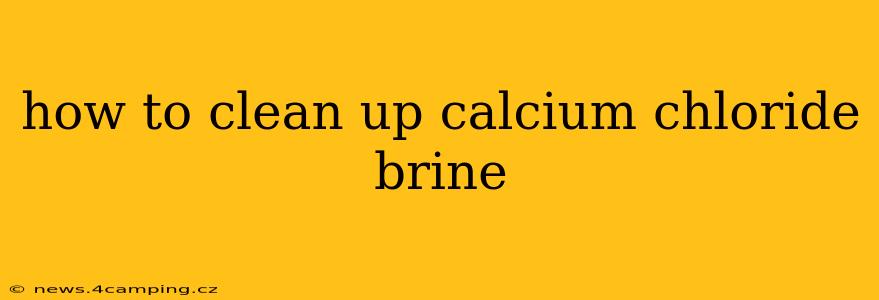Calcium chloride brine, while effective for de-icing and other applications, can be messy and require careful cleanup. Improper handling can lead to environmental damage and safety hazards. This guide provides a comprehensive approach to cleaning up calcium chloride brine spills, addressing common concerns and best practices.
What is Calcium Chloride Brine?
Before diving into cleanup methods, let's understand what we're dealing with. Calcium chloride brine is a solution of calcium chloride dissolved in water. It's a highly effective de-icer because it lowers the freezing point of water significantly, preventing ice formation even at sub-zero temperatures. However, its corrosive nature necessitates careful handling and cleanup.
Safety Precautions: Protecting Yourself and the Environment
Before starting any cleanup, prioritize safety:
- Personal Protective Equipment (PPE): Always wear gloves, eye protection, and appropriate clothing to prevent skin and eye irritation. Calcium chloride can be corrosive.
- Ventilation: Ensure adequate ventilation, especially in enclosed spaces, to avoid inhaling the dust or mist.
- Environmental Considerations: Prevent runoff into storm drains or waterways. Contain the spill as much as possible.
How to Clean Up Calcium Chloride Brine Spills: A Step-by-Step Guide
The best approach to cleaning up calcium chloride brine depends on the size and location of the spill.
Small Spills:
- Absorption: For small spills, use absorbent materials like kitty litter, sand, or commercially available spill cleanup products. These materials will soak up the brine, making it easier to dispose of.
- Scooping and Disposal: Once the absorbent material has absorbed the brine, carefully scoop it into a sealed container. Dispose of it according to local regulations. Often, this involves treating it as hazardous waste.
- Washing: After absorption, wash the affected area with clean water to remove any remaining residue.
Large Spills:
Large spills require a more organized approach:
- Containment: First, contain the spill to prevent further spread. Use sandbags, absorbent booms, or other barriers to create a perimeter.
- Dilution: Dilute the brine with large quantities of water to reduce its concentration and corrosiveness. This makes it safer to handle and reduces the environmental impact.
- Neutralization (if necessary): In extreme cases or if dealing with highly concentrated brine, consider using a neutralizing agent, but only if you are properly trained in handling chemicals. Incorrect use could create new hazards. Consult with a professional hazardous materials cleanup team.
- Vacuuming/Pumping: Use a vacuum or pump to remove the diluted brine solution. This requires specialized equipment.
- Disposal: Dispose of the collected brine and wash water according to local regulations. This will likely involve contacting a hazardous waste disposal facility.
Dealing with Calcium Chloride Brine on Different Surfaces:
The cleanup method may vary depending on the surface affected:
- Concrete: Washing with water is usually sufficient after absorption and removal of the bulk brine.
- Asphalt: Similar to concrete, washing with water is usually sufficient, but be mindful of potential damage due to the brine's corrosive properties.
- Plants/Vegetation: Calcium chloride can damage plants. Flush the affected area thoroughly with water to minimize damage. Consider using a diluted solution of baking soda to help neutralize the acid.
- Vehicles: Immediately wash affected areas of vehicles to prevent corrosion.
What Happens if I Don't Clean Up Calcium Chloride Brine?
Leaving calcium chloride brine unattended can lead to several issues:
- Corrosion: The brine is highly corrosive and can damage concrete, metal, and other materials.
- Environmental Damage: Runoff into waterways can harm aquatic life.
- Slip and Fall Hazards: The brine can create slippery conditions, increasing the risk of accidents.
Frequently Asked Questions (FAQs)
Can I use regular household cleaners to clean up calcium chloride brine?
No, regular household cleaners are not suitable for cleaning up calcium chloride brine. The brine’s corrosive nature may react unpredictably with other cleaning agents.
Is calcium chloride brine hazardous waste?
Yes, calcium chloride brine is often considered hazardous waste and should be disposed of according to local regulations. Contact your local waste management authority for proper disposal guidelines.
Can I pour calcium chloride brine down the drain?
No. Pouring calcium chloride brine down the drain can damage pipes and harm the environment. Always follow proper disposal procedures.
What are some environmentally friendly alternatives to calcium chloride brine?
Several alternatives exist, including magnesium chloride, potassium acetate, and beet juice-based de-icers. However, their effectiveness varies depending on temperature and other factors.
This comprehensive guide should equip you with the knowledge and steps required for safely and effectively cleaning up calcium chloride brine. Remember, safety and environmental protection are paramount. If dealing with a large spill or unsure about the proper procedure, contact a professional hazardous materials cleanup team.
